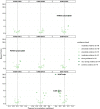Association between aerobic fitness and the functional connectome in patients with schizophrenia
- PMID: 35488054
- PMCID: PMC9508005
- DOI: 10.1007/s00406-022-01411-x
Association between aerobic fitness and the functional connectome in patients with schizophrenia
Abstract
Background: Schizophrenia is accompanied by widespread alterations in static functional connectivity associated with symptom severity and cognitive deficits. Improvements in aerobic fitness have been demonstrated to ameliorate symptomatology and cognition in people with schizophrenia, but the intermediary role of macroscale connectivity patterns remains unknown.
Objective: Therefore, we aim to explore the relation between aerobic fitness and the functional connectome in individuals with schizophrenia. Further, we investigate clinical and cognitive relevance of the identified fitness-connectivity links.
Methods: Patients diagnosed with schizophrenia were included in this cross-sectional resting-state fMRI analysis. Multilevel Bayesian partial correlations between aerobic fitness and functional connections across the whole brain as well as between static functional connectivity patterns and clinical and cognitive outcome were performed. Preliminary causal inferences were enabled based on mediation analyses.
Results: Static functional connectivity between the subcortical nuclei and the cerebellum as well as between temporal seeds mediated the attenuating relation between aerobic fitness and total symptom severity. Functional connections between cerebellar seeds affected the positive link between aerobic fitness and global cognition, while the functional interplay between central and limbic seeds drove the beneficial association between aerobic fitness and emotion recognition.
Conclusion: The current study provides first insights into the interactions between aerobic fitness, the functional connectome and clinical and cognitive outcome in people with schizophrenia, but causal interpretations are preliminary. Further interventional aerobic exercise studies are needed to replicate the current findings and to enable conclusive causal inferences.
Trial registration: The study which the manuscript is based on is registered in the International Clinical Trials Database (ClinicalTrials.gov identifier [NCT number]: NCT03466112) and in the German Clinical Trials Register (DRKS-ID: DRKS00009804).
Keywords: Exercise; Fitness; Functional connectivity; Neuroimaging; Schizophrenia; fMRI.
© 2022. The Author(s).
Conflict of interest statement
AS was an honorary speaker for TAD Pharma and Roche and a member of Roche advisory boards. AH is co-editor of the German (DGPPN) schizophrenia treatment guidelines and first author of the WFSBP schizophrenia treatment guidelines; he has been on the advisory boards and has received speaker fees from Janssen-Cilag, Lundbeck, and Otsuka. PF is a co-editor of the German (DGPPN) schizophrenia treatment guidelines and a co-author of the WFSBP schizophrenia treatment guidelines; he is on the advisory boards and receives speaker fees from Janssen, Lundbeck, Otsuka, Servier, and Richter. AML has received consultant fees from Boehringer Ingelheim, Elsevier, Brainsway, Lundbeck Int. Neuroscience Foundation, Lundbeck A/S, Sumitomo Dainippon Pharma Co., Academic Medical Center of the University of Amsterdam, Synapsis Foundation-Alzheimer Research Switzerland, IBS Center for Synaptic Brain Dysfunction, Blueprint Partnership, University of Cambridge, Dt. Zentrum für Neurodegenerative Erkrankungen, Zürich University, Brain Mind Institute, L.E.K. Consulting, ICARE Schizophrenia, Science Advances, Fondation FondaMental, v Behring Röntgen Stiftung, The Wolfson Foundation, and Sage Therapeutics; Additionally, he has received speaker fees from Lundbeck International Foundation, Paul-Martini-Stiftung, Lilly Deutschland, Atheneum, Fama Public Relations, Institut d'investigacions Biomèdiques August Pi i Sunyer (IDIBAPS), Janssen-Cilag, Hertie Stiftung, Bodelschwingh-Klinik, Pfizer, Atheneum, University of Freiburg, Schizophrenia Academy, Hong Kong Society of Biological Psychiatry, Fama Public Relations, Spanish Society of Psychiatry, Italian Society of Biological Psychiatry, Reunions I Ciencia S.L., and Brain Center Rudolf Magnus UMC Utrecht as well as the Prix Roger de Spoelberch grant and the CINP Lilly Neuroscience Clinical Research Award 2016. BEW’s spouse is an employee of Siemens Healthineers. IM, LR, DK, TK, BP, DH, ES, SM, VS, MC, EW, LL, AR, ML, KV, IP, BM, JP and SS report no conflicts of interest.
Figures







References
-
- Brandl F, Avram M, Weise B, Shang J, Simões B, Bertram T, Hoffmann Ayala D, Penzel N, Gürsel DA, Bäuml J, Wohlschläger AM, Vukadinovic Z, Koutsouleris N, Leucht S, Sorg C. Specific substantial dysconnectivity in schizophrenia: a transdiagnostic multimodal meta-analysis of resting-state functional and structural magnetic resonance imaging studies. Biol Psychiatry. 2019;85:573–583. doi: 10.1016/j.biopsych.2018.12.003. - DOI - PubMed
MeSH terms
Associated data
Grants and funding
LinkOut - more resources
Full Text Sources
Medical

